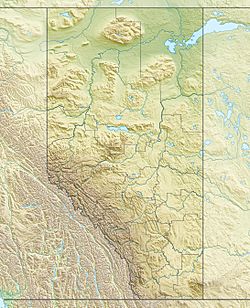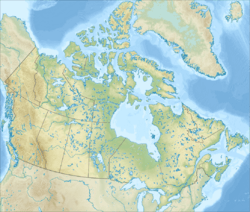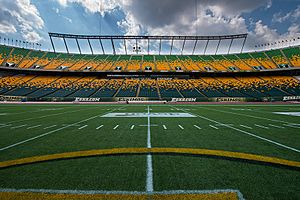Commonwealth Stadium facts for kids
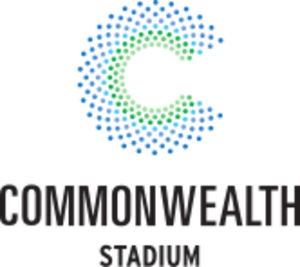 |
|
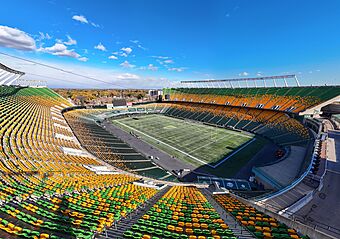
Commonwealth Stadium in October 2024.
|
|
| Location | 11000 Stadium Road Edmonton, Alberta, Canada |
|---|---|
| Coordinates | 53°33′30″N 113°28′30″W / 53.55833°N 113.47500°W |
| Public transit | |
| Owner | City of Edmonton |
| Capacity |
|
| Record attendance | 66,835 (U2 360° Tour) |
| Surface |
|
| Construction | |
| Opened | July 15, 1978 |
| Renovated | 2001, 2008 |
| Expanded | 1982, 2013 |
| Construction cost | C$20.9 million ($80.9 million in 2021 dollars ) Expansion: 1982: CA$11 million ($28.4 million in 2021 dollars ) 2013: CA$12 million ($13.8 million in 2021 dollars ) Renovations: 2001: $24 million ($34.7 million in 2021 dollars ) 2008: CA$112 million ($139 million in 2021 dollars ) Total cost: $296.8 million in 2021 dollars |
| Architect | Bell, McCulloch, Spotowski and Associates |
| Tenants | |
|
|
Commonwealth Stadium is a large outdoor stadium in Edmonton, Alberta, Canada. It is the biggest stadium in Canada, with seats for 56,302 people. This stadium is mainly used for Canadian football. It also hosts many other exciting events. These include track and field, soccer, rugby union, and big concerts.
The stadium was built for the 1978 Commonwealth Games. That's where it got its name! It replaced Clarke Stadium as the home of the Edmonton Eskimos/Elks football team. Over the years, the stadium has grown and changed. It hosted the 1983 Summer Universiade and five Grey Cup championships.
Many important soccer games have taken place here. These include matches for the Canada men's national soccer team and several FIFA World Cup tournaments for youth and women. Other major events include the 2001 World Championships in Athletics and the 2006 Women's Rugby World Cup.
Contents
History of Commonwealth Stadium
Building a New Stadium
Before Commonwealth Stadium, Edmonton's main sports venue was Clarke Stadium. In the early 1970s, Edmonton wanted to host the 1978 Commonwealth Games. The city decided to build a brand-new stadium instead of just updating Clarke Stadium.
Construction began in 1975. The stadium was designed to hold 40,000 people. It was built next to Clarke Stadium. The city also built other new sports places, like the Kinsmen Aquatic Centre.
Early Years and Growth
Commonwealth Stadium officially opened on July 15, 1978. It had 42,500 seats and a natural grass field. It was one of the few major stadiums in Canada with real grass.
In 1981, Edmonton was chosen to host the 1983 Summer Universiade. This led to a big upgrade for the stadium. About 18,000 more seats were added, bringing the total to over 60,000. This made it the second-largest stadium in Canada at the time.
Modern Updates and Changes
Before the 2001 World Championships in Athletics, the stadium got a $24-million makeover. This included a new look for the outside, better lighting, and a new running track.
In 2010, the natural grass field was replaced with FieldTurf artificial turf. This change helped reduce player injuries and allowed more events to be held. It also meant the field stayed green all season, even in cold weather.
A major renovation started in 2009. It added a new field house, locker rooms, and office spaces. This new complex, called the Commonwealth Community Recreation Centre, also has a pool and a fitness center.
In 2012, all the old seats were replaced with new, wider ones. The colors changed to green and yellow, matching the Edmonton Elks team colors. Because the new seats were wider, the stadium's capacity was slightly reduced to 56,302.
Since 2016, the field has had different names due to sponsorship deals. It was "The Brick Field" and is now "Play Alberta Field at Commonwealth Stadium." For the 2024 CFL season, the Edmonton Elks decided to only sell tickets for the lower bowl, reducing the available seats to 31,000 for their games.
Stadium Facilities
Seating and Field
Commonwealth Stadium can seat 56,302 people. It has two large sections of seats along the sides and smaller sections in the corners and ends. The side seats are wider and have cup holders. The seats are arranged in a cool pattern of dark green, yellow, and light green colors.
The stadium uses a special artificial turf system called Shaw Sports Turf Powerblade Elite 2.5S. This turf has extra cushioning to make it safer for players. It doesn't have permanent lines, so it can be marked for different sports like football or soccer. There's also a high-quality running track around the field, certified for international athletics events.
Recreation Centre
The Commonwealth Stadium complex includes the Field House. This is a huge three-story training facility. It has an indoor running track, an artificial turf training field, and a fitness room.
The Field House is part of the Commonwealth Community Recreation Centre. This center also features a large aquatic center with pools and water slides. There are also administrative offices and another fitness center. The building is designed to be environmentally friendly.
Getting There
The stadium is easy to reach by public transport. The Edmonton Light Rail Transit (LRT) Capital Line serves Stadium station, which is right by the stadium. During Elks games, more trains run to handle the crowds.
The City of Edmonton and the Elks team also have a "Green & Go" program. This offers free bus rides to the stadium from several parking lots around the city. Game tickets also work as free fare on the LRT for a few hours before and after games. This helps reduce traffic and parking issues in the neighborhood.
Exciting Events at the Stadium
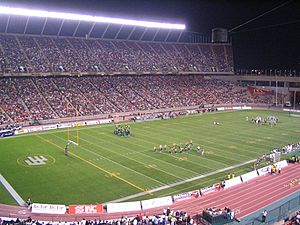
Athletics Competitions
Commonwealth Stadium was the main venue for the 1978 Commonwealth Games. These games brought athletes from many countries to Edmonton. Canada had its best performance ever, winning many medals. The stadium hosted all the track and field events, plus the opening and closing ceremonies.
The stadium also hosted the 1983 Summer Universiade, another big international sports event. Later, in 2001, it was the site of the 2001 World Championships in Athletics, drawing athletes from nearly 200 nations.
Canadian Football Games
Commonwealth Stadium has been the home of the Edmonton Elks (formerly the Edmonton Eskimos) since 1978. Fans love coming to watch the Elks play here. The record attendance for a regular-season game was 62,517 in 2009.
The stadium has hosted the Grey Cup, the championship game of the Canadian Football League (CFL), five times. These exciting games took place in 1984, 1997, 2002, 2010, and 2018. The 2010 Grey Cup had the largest crowd ever at the stadium, with 63,317 fans!
| Game | Date | Winning team | Score | Losing team | Attendance |
|---|---|---|---|---|---|
| 72nd | November 18, 1984 | Winnipeg Blue Bombers (8) | 47–17 | Hamilton Tiger-Cats | 60,081 |
| 85th | November 16, 1997 | Toronto Argonauts (14) | 47–23 | Saskatchewan Roughriders | 60,431 |
| 90th | November 24, 2002 | Montreal Alouettes (5) | 25–16 | Edmonton Eskimos | 62,531 |
| 98th | November 28, 2010 | Montreal Alouettes (7) | 21–18 | Saskatchewan Roughriders | 63,317 |
| 106th | November 25, 2018 | Calgary Stampeders (8) | 27–16 | Ottawa Redblacks | 55,819 |
Soccer Matches
Commonwealth Stadium has hosted many important soccer games. The Canada men's national soccer team has played several FIFA World Cup qualification matches here. In 1994, a record 51,936 fans watched Canada tie Brazil 1–1. In 2021, Canada famously beat Mexico 2–1 in a World Cup qualifier, a game nicknamed "Estadio Iceteca" because of the cold weather!
The stadium has also seen the Canada women's national soccer team play. In 2015, a record crowd of 53,058 watched Canada beat China 1–0 during the 2015 FIFA Women's World Cup.
Commonwealth Stadium has been a host for several FIFA youth tournaments. It hosted 12 matches of the first-ever 2002 FIFA U-19 Women's World Championship. The final, where the United States beat Canada, drew a world-record crowd of 47,784 for youth women's soccer. It also hosted games for the 2007 FIFA U-20 World Cup and the 2014 FIFA U-20 Women's World Cup.
| Date | Time (MDT) | Team #1 | Result | Team #2 | Round | Attendance |
|---|---|---|---|---|---|---|
| 6 June 2015 | 16:00 | 1–0 | Group A | 53,058 | ||
| 19:00 | 0–1 | 53,058 | ||||
| 11 June 2015 | 16:00 | 1–0 | 35,544 | |||
| 19:00 | 0–0 | 35,544 | ||||
| 16 June 2015 | 15:00 | 1–2 | Group C | 10,177 | ||
| 18:00 | 1–1 | Group D | 10,177 | |||
| 20 June 2015 | 17:30 | 1–0 | Round of 16 | 15,958 | ||
| 22 June 2015 | 18:00 | 2–0 | 19,412 | |||
| 27 June 2015 | 14:00 | 0–1 | Quarterfinals | 19,814 | ||
| 1 July 2015 | 17:00 | 2–1 | Semifinals | 31,467 | ||
| 4 July 2015 | 14:00 | 0–1 | Third place play-off | 21,483 |
Concerts and Music Events
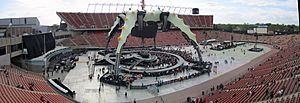
Commonwealth Stadium is a popular spot for huge concerts. Many famous artists have performed here. These include Pink Floyd, Beyoncé, David Bowie, The Rolling Stones, U2, Taylor Swift, Bon Jovi, and Guns N' Roses.
The U2 360° Tour in 2011 set a stadium attendance record for a concert, with 66,835 people. The stadium continues to host major music events, bringing big names to Edmonton.
| Date | Artist(s) | Opening act(s) | Tour | Tickets sold | Revenue | Additional notes |
|---|---|---|---|---|---|---|
| August 7, 1983 | David Bowie | Peter Gabriel The Tubes |
Serious Moonlight Tour | — | — | |
| August 17, 1987 | David Bowie | Duran Duran The Georgia Satellites The Northern Pikes |
Glass Spider Tour | — | — | |
| June 12, 1992 | Genesis | — | We Can't Dance Tour | — | — | |
| June 28, 1994 | Pink Floyd | — | The Division Bell Tour | 57,701 / 57,701 | $1,834,004 | |
| October 4, 1994 | The Rolling Stones | Colin James | Voodoo Lounge Tour | 121,604/ 121,604 | $4,327,764 | |
| October 5, 1994 | ||||||
| June 14, 1997 | U2 | Fun Lovin' Criminals | PopMart Tour | 90,000 / 90,000 | $3,493,456 | |
| June 15, 1997 | ||||||
| October 2, 1997 | The Rolling Stones | Blues Traveler | Bridges to Babylon Tour | 44,036 / 44,036 | $2,033,971 | |
| August 18, 1998 | Backstreet Boys | Aaron Carter | Backstreet's Back Tour | — | — | |
| June 2, 2007 | The Police | Sloan Fiction Plane |
The Police Reunion Tour | 29,592 / 29,592 | $3,216,118 | |
| July 9, 2009 | Taylor Swift Kenny Chesney |
Gloriana Kelly Pickler Lady Antebellum Miranda Lambert |
Fearless Tour Sun City Carnival Tour |
33,910 / 44,500 | $2,540,906 | This concert was part of Commonwealth Country. |
| August 26, 2009 | AC/DC | The Answer | Black Ice World Tour | 55,838 / 55,838 | $4,764,061 | |
| July 15, 2010 | Bon Jovi | Kid Rock | The Circle Tour | 40,451 / 40,451 | $2,811,477 | |
| June 1, 2011 | U2 | The Fray | U2 360° Tour | 66,835 / 66,835 | $6,498,291 | |
| July 21, 2015 | One Direction | Icona Pop | On the Road Again Tour | 40,989 / 40,989 | $3,188,215 | |
| September 20, 2015 | AC/DC | Vintage Trouble | Rock or Bust World Tour | 55,000 / 55,000 | — | |
| May 20, 2016 | Beyoncé | — | The Formation World Tour | 39,299 / 39,299 | $3,723,830 | This concert was performed in cold and rainy conditions. |
| August 16, 2017 | Metallica | Avenged Sevenfold Gojira |
WorldWired Tour | — | — | |
| August 30, 2017 | Guns N' Roses | Our Lady Peace | Not in This Lifetime... Tour | 44,393 / 46,656 | $4,780,270 | The band covered "Wichita Lineman" by Glen Campbell and "I Got You (I Feel Good)" by James Brown. |
| June 24, 2022 | Garth Brooks | Mitch Rossell | The Garth Brooks Stadium Tour | 130,000/ 130,000 | $9,387,811 | |
| June 25, 2022 | ||||||
| September 4, 2022 | Mötley Crüe | The Stadium Tour | 46,077 / 46,077 | $4,845,322 | ||
| June 3, 2023 | Luke Combs | Riley Green Lainey Wilson |
Luke Combs World Tour | |||
| August 23, 2024 | Metallica | Pantera Mammoth WVH |
M72 World Tour | 116,035 / 116,035 | $12,672,187 | |
| August 25, 2024 | Five Finger Death Punch Ice Nine Kills |
|||||
| August 31, 2024 | Pink | Sheryl Crow KidCutUp The Script |
P!NK: Summer Carnival | |||
| July 19, 2025 | The Weeknd | Mike Dean | After Hours til Dawn Tour |
Ice Hockey Games
Commonwealth Stadium has hosted two special outdoor ice hockey games. The 2003 Heritage Classic was the first-ever regular-season National Hockey League (NHL) game played outdoors. The Edmonton Oilers played the Montreal Canadiens in freezing temperatures, with the Canadiens winning 4-3.
Twenty years later, in 2023, the stadium hosted the 2023 Heritage Classic. This time, the Oilers played their rivals, the Calgary Flames, in an outdoor "Battle of Alberta," with the Oilers winning 5-2.
Rugby Union Matches
The stadium has also been a venue for rugby union. It hosted matches for the Churchill Cup several times. In 2006, the finals of the 2006 Women's Rugby World Cup were played here. In 2018, the Canadian Men's National team played Scotland in a test match at the stadium.
Other Notable Events
- In 1980, a large religious event by Billy Graham took place at the stadium.
- In 1983, a professional baseball team, the Edmonton Trappers, played an exhibition game against the California Angels from Major League Baseball.
- In 2022, Pope Francis led an open-air Mass for nearly 50,000 people during his visit to Canada.
- Also in 2022, Monster Jam brought its exciting truck show to the stadium.
- In 2024, the stadium hosted the 2024 IFAF World Junior Championship, which was the first time American football was played there.
Images for kids
See also
 In Spanish: Estadio de la Mancomunidad para niños
In Spanish: Estadio de la Mancomunidad para niños



